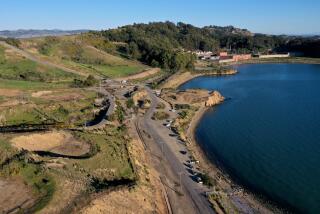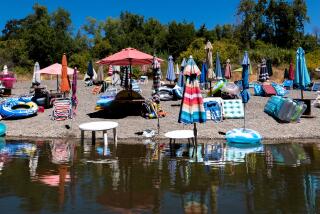Controversy Between Fishermen, Park Service Roils Glacier Bay
- Share via
GLACIER BAY NATIONAL PARK, Alaska — Amid the vast waters of Glacier Bay bob a few small orange floats, beacons of a conflict that pits the U.S. Park Service against fishermen, neighbor against neighbor and the state of Alaska against the federal government.
The floats lead to crab pots, but not the commercial pots that hauled tons of Dungeness crab out of the bay during the last few decades, bolstering the economy of the nearby community of Gustavus and bringing fresh shellfish to restaurant tables across America.
Those traps were pulled for good in August as part of a planned phaseout of commercial fishing in Glacier Bay, a proposal that has local fishermen up in arms and the state ready to sue for the right to manage the bay’s waters.
The conflict goes to the heart of Alaska’s relationship with its huge expanses of undeveloped land and water. Should Glacier Bay, with its towering mountains, grinning sea otters and calving glaciers, be left completely alone for the benefit of researchers, kayakers and cruise ship tourists? Or should fishermen be allowed to continue pulling a living from its icy waters?
Jim Taggart, of the U.S. Geological Survey, and the crew of the research vessel Tamnik wear the heavy orange rain gear and neoprene boots typical of southeast Alaska fishermen, but they probe waters that wouldn’t interest commercial crabbers--the parts of Glacier Bay most recently scoured by receding ice.
Huddled in a steady rain, researcher Elizabeth Solomon records the vital statistics of each small crab on waterproof paper before her crew mates flip the struggling shellfish back over the side.
“You might look at Glacier Bay as an ecological catastrophe,” said Taggart, as the Tamnik hauled its test crab pots off the glacier-scarred sea floor. “We’re looking at how ecosystems recover.”
Work like this epitomizes the Park Service’s vision of Glacier Bay as a largely untouched marine environment, its wildlife undisturbed by the pots, nets and lines of commercial fishermen.
Tomie Lee, the park’s superintendent, calls the policy a return to the original idea of Glacier Bay National Preserve, which became a national park in 1980.
*
“From the very beginning it was for research purposes,” Lee said. “There is nothing living here that can be more than 200 years old because it was blanketed with ice.”
The vision won’t come true right away. Fierce resistance to the fishing closure by Alaska’s powerful congressional delegation means some fishermen will get lifetime permits to fish for salmon, halibut and tanner crab, also known as snow crab, in parts of the bay.
Meanwhile, the state is ready to sue the federal government for control of the park’s waters. Alaska Gov. Tony Knowles contends the submerged lands in the park were conveyed to Alaska at statehood in 1959. In general, states own submerged lands within three miles of their coastlines.
Only Dungeness crabbing has been completely stopped. Fishermen sought the tasty orange crustaceans mostly in areas of the park designated as wilderness. Federal courts have sided with environmentalists who sued to end commercial fishing in wilderness waters.
Deb Woodruff and Charlie Clements spent nearly two decades hauling Dungeness crab out of the park and the last few years fighting the closure. Now weeds and wildflowers poke through their 300 idled pots as they embark on an uncertain future as innkeepers in nearby Gustavus.
Although they received about $400,000 from the Park Service to surrender their crab permit, the couple think their livelihoods and lifestyle were sacrificed on an altar of political correctness. They point to the sportfishermen and crabbers who will be able to continue fishing the bay, and to commercial fishing in national parks in Michigan and Maine.
“This is strictly a political decision,” Woodruff said. “It was seen as a nonissue before. Everybody knew that the fishermen had their place.”
Woodruff’s resentment is mostly aimed at the Park Service and the Department of the Interior, but she’s also angry at local environmentalists such as Kim Heacox, a former park ranger who heads the Friends of Glacier Bay.
*
Heacox, a photographer whose work celebrates Alaska’s stunning scenery, thinks leaving part of Alaska’s marine ecosystem alone will be worth the price in the future.
“Conservation hurts sometimes. I wish it didn’t,” Heacox said. “We’re harvesting the oceans and not letting a single field go fallow.”
The end to the harvest won’t come anytime soon. While Dungeness crabbers move away or look for other work, the Park Service has proposed rules that will likely let hundreds of halibut, salmon and tanner crab fishermen fish out their days in the bay.
Tanner crabbers and salmon fishermen who have fished the bay in three of the last 10 years will qualify for lifetime permits, as will halibut fishermen who fished in two of the last seven years.
The rules divide local fishermen into haves and have-nots, a line that ran through the scant inches between Peder Turner and Gene Farley as they painstakingly baited halibut hooks on Farley’s boat, the Laura Loree.
Turner expects to qualify for a lifetime permit, but Farley said the proposed rules will leave him out because he fished as a crewman until a few years ago.
“I think it is a very rotten deal,” Farley said. “It’s looking like I’m just getting ready to be ousted.”
Although Farley will likely qualify for some of the $23 million earmarked by Congress to compensate fishermen, fish processors and local communities, he resents the unwanted changes that loom in his life.
“Selling out people’s lifestyles and buying them off doesn’t cut it,” Farley said. “I’d just as soon not have the money and continue to fish.”
More to Read
Sign up for Essential California
The most important California stories and recommendations in your inbox every morning.
You may occasionally receive promotional content from the Los Angeles Times.










